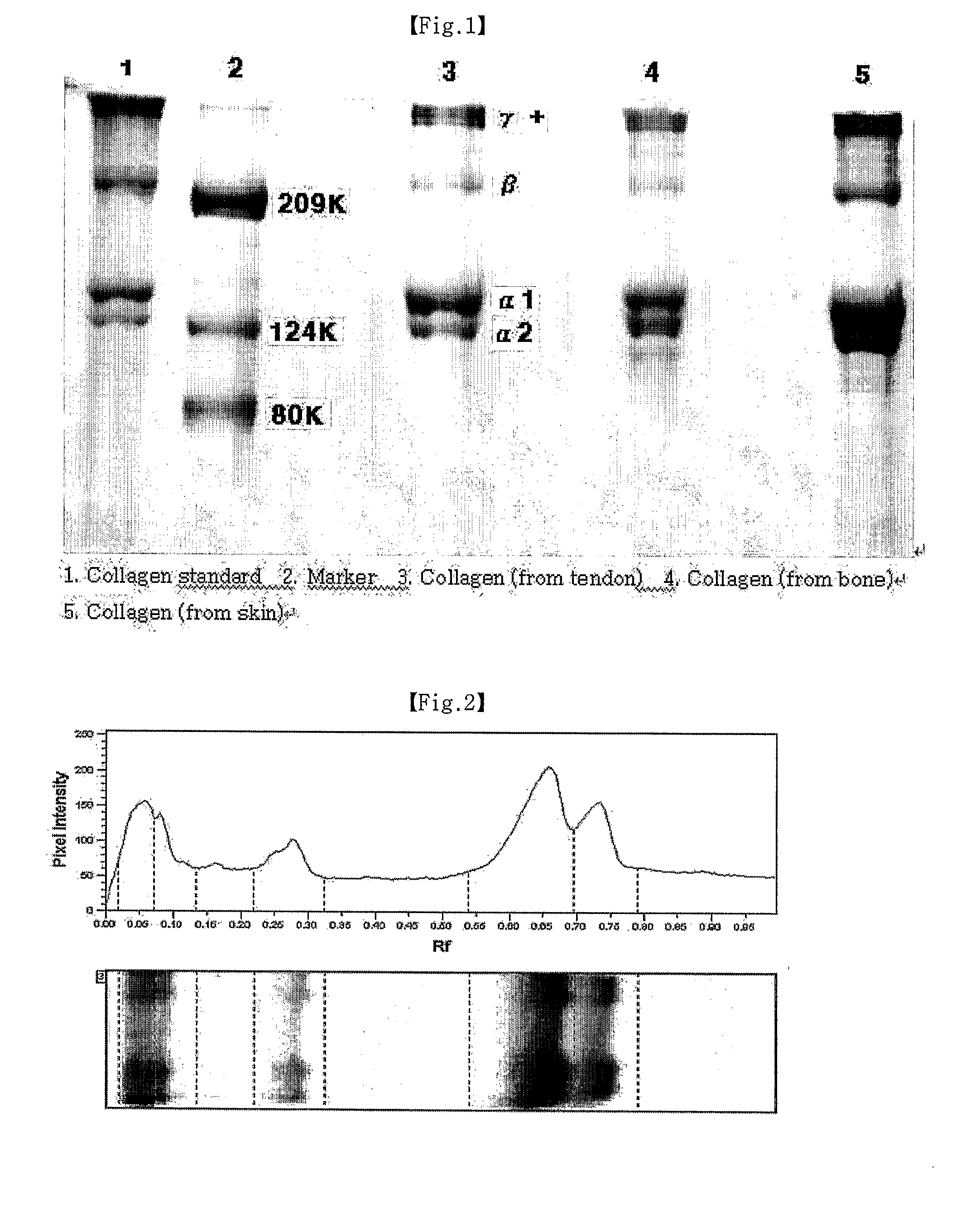Method of Separating Collagen From the Various Animal Tissues for Producing Collagen Solution and Product Using the Same
- Summary
- Abstract
- Description
- Claims
- Application Information
AI Technical Summary
Benefits of technology
Problems solved by technology
Method used
Image
Examples
example 1
[0040]Porcine bone tissue was made into a powder having a particle size of 1 to 500 and was acid-treated with 0.5N HCl. Then, the acid-treated bone tissue was repeatedly treated with pepsin (2 to 5 times) for a long period of time (3 to 7 days) to separate type I collagen which was then subjected to salt treatment for fractionation and ethanol treatment, thereby obtaining collagen as 5 to 10% of the initial tissue weight. Specifically, this procedure will be described in more detail hereinafter:
[0041]1. Porcine-isolated bone tissue was thoroughly washed with distilled water, ethanol, acetone and the like.
[0042]2. The bone tissue was cut into a doughnut shape and stored at −20° C.
[0043]3. In order to separate collagen from the bone tissue, the bone tissue was made into a powder having a particle size of 1 to 500
[0044]4. The pulverized bone tissue was washed with ethanol and distilled water.
[0045]5. The thus-washed bone powder was treated overnight with 0.5N HCl while being shaken a...
example 2
[0058]Porcine cartilage tissue was made into a powder and was acid-treated with 0.5N HCl. Then, the acid-treated cartilage tissue was repeatedly treated with pepsin to separate type II collagen which was then subjected to salt treatment for fractionation and ethanol treatment, thereby obtaining collagen as 5 to 10% of the initial tissue weight. Specifically, this procedure will be described in more detail hereinafter:
[0059]1. Porcine-isolated cartilage tissue was thoroughly washed with distilled water, ethanol, acetone and the like.
[0060]2. In order to separate collagen from the cartilage tissue, the cartilage tissue was made into a powder having a particle size of 1 to 500
[0061]3. The pulverized cartilage tissue was washed with ethanol and distilled water.
[0062]4. The thus-washed cartilage tissue was treated overnight with a guanidine-HCl solution (4M guanidine-HCl, 0.05M Tris-HCl, pH 7.5),
[0063]5. The overnight-treated cartilage powder was washed once or twice with 0.1N HCl.
[0064]...
example 3
[0077]Porcine skin tissue was made into a section (500 to 5 mm thickness), and the tissue section was placed in a net having a lattice size of 200 to 500 and (was acid-treated with 0.1N HCl. Then, the acid-treated tissue) was repeatedly treated with pepsin to separate type I collagen which was then subjected to salt treatment for fractionation and ethanol treatment, thereby obtaining collagen as 10 to 15% of the initial tissue weight. Specifically, this procedure will be described in more detail hereinafter:
[0078]1. Porcine-isolated skin tissue was thoroughly washed with distilled water, ethanol and the like, and stored at −20° C.
[0079]2. In order to separate collagen from the skin tissue, the skin tissue was made into a section having a thickness of 500 to 5 mm.
[0080]3. The tissue section was placed in a net having a lattice size of 200 to 500 and washed with ethanol and distilled water.
[0081]4. The thus-washed tissue section was treated with pepsin (pepsin was treated in a 10 t...
PUM
| Property | Measurement | Unit |
|---|---|---|
| Temperature | aaaaa | aaaaa |
| Temperature | aaaaa | aaaaa |
| Temperature | aaaaa | aaaaa |
Abstract
Description
Claims
Application Information
 Login to View More
Login to View More - R&D
- Intellectual Property
- Life Sciences
- Materials
- Tech Scout
- Unparalleled Data Quality
- Higher Quality Content
- 60% Fewer Hallucinations
Browse by: Latest US Patents, China's latest patents, Technical Efficacy Thesaurus, Application Domain, Technology Topic, Popular Technical Reports.
© 2025 PatSnap. All rights reserved.Legal|Privacy policy|Modern Slavery Act Transparency Statement|Sitemap|About US| Contact US: help@patsnap.com



